Symbols of the Reforged Sword
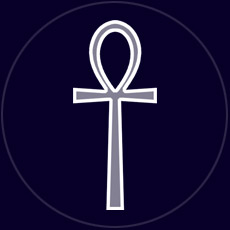
The Key of Life. A loop above a ‘T’ cross. The loop represents wholeness. The crossbar separates the spiritual realm above from the physical realm below. The vertical axis, dividing the manifest universe in two, signifies duality.
The loop is the yoni, the vertical axis the phallus. Together: female and male in harmonised polarity.
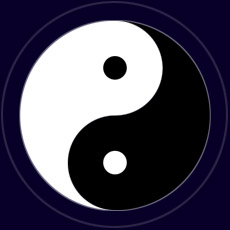
The interplay of two universal forces, each carrying within itself the seed of the other.
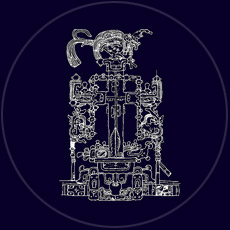
The Mayan Tree of Life. Celestial bird in its branches, double-headed serpent across its trunk. Roots in Xibalba, the Mayan Underworld. Often depicted in a cruciform shape.
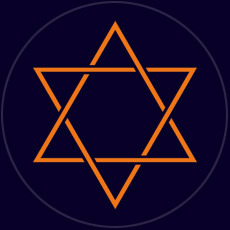
The upward pointing triangle is male, the downward pointing triangle female. Together: male and female entwined.

A cross in the most basic sense is a marker. It depicts a meeting point, a nexus, a point of convergence. It is a crossing point between worlds. A cross marks the focus of something (or someone): a centre of stillness between opposing polarities.
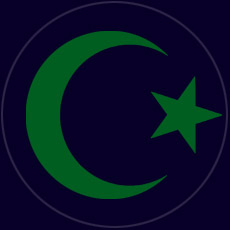
In the story of The Reforged Sword, the Crescent Moon and Star is deeply connected to the Thirteenth Path, the bridge between Heaven and Earth. On the night featured in Myth Becomes Reality (which took place in Dubai, a country in which the symbol is ubiquitous) the dramatic cloud played out its lightshow beneath a crescent moon in a clear sky full of stars. Qabalistic teaching speaks of another connection to the Thirteenth Path. The path’s astrological attribution is the Moon (depicted as a crescent) while one of its titles is Priestess of the Silver Star.

Earth = Body Air = Mind Water = Emotions Fire = Will

The matrix upon which all else is built.
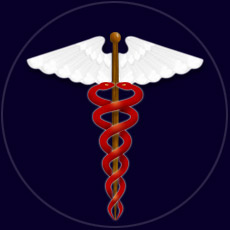
Many traditions tell of a mythical Tree of Life, its trunk connecting the Heavens, Earth and Underworld. Often a celestial bird is found in its branches, while at its roots or across the trunk lies a cosmic snake.
The Caduceus is one of the most stylised versions, the Tree of Life stripped to its essential elements. Bird becomes wings, cosmic snake the entwined serpents and trunk the central staff.
In keeping with the Tree’s role as an axis between worlds, the Caduceus is a herald of the messengers of the gods, notably Hermes and Iris, both walkers between worlds.
The Homeric Hymn to Apollo tells how the sun god Apollo gave Hermes the Caduceus as a gift in return for his lyre.
The Caduceus has since become a common symbol for the healing professions, although it has been suggested in some quarters that this is a mistake, possibly arising from a mix up with the rod of Aesclepius – a wingless staff entwined by a single snake. The idea that the Caduceus is a symbol of the trickster god – a patron of traders, thieves, gamblers and liars – leads some to denounce as inappropriate its use as a symbol of the healing professions.
However, given that the Caduceus originated with Apollo – god of medicine as well as father of Aesclepius – the correspondence is entirely appropriate. Just as the Sword can be used to unite or divide, so can the Caduceus be used for good or mischief. As the god of boundaries and divisions, Hermes highlights differences and causes upset in order to bring unexamined prejudices to light. As well being a trickster god, he is also the god of wisdom and knowledge, scribe of the gods.
Like many mythological motifs, the thing that takes us away from unity is the very thing that can show us the way back.
The most persuasive argument for the enduring connection of the Caduceus with medicine lies in the symbol’s imagery. Depicting forces in unity, it is related to wholeness and health in the widest sense. The wings speak of the ‘lofty’ – the spiritual, the conscious, the energies of the mind. The snakes speak of the ‘base’ – the material, the unconscious, the energies of the body. The central staff is the axis upon which all aspects are united and held in dynamic and vibrant balance.
The Caduceus is a symbol of life.

While its origins lie in esoteric Judaism, the application of the Qabalistic Tree of Life extends far beyond the boundaries of a single religious viewpoint. In fact part of its value lies in its ability to highlight commonalities between apparently different belief systems. It provides the foundation stone for the Western Mystery Tradition, a repository of wisdom teachings from sources as diverse as the ancient Egyptian priesthood, Greek mystery schools, Celtic paganism, esoteric Christianity, Islamic alchemy and the Arthurian mythos.
It is said the Tree of Life can help unlock the secrets behind surface appearances. It is a code book, a map, an instruction manual of symbolism. In The Mystical Qabalah it is summarised thus:
The curious symbol-system known to us as the Tree of Life is an attempt to reduce to diagrammatic form every force and factor in the manifested universe and the soul of man; to correlate them to one another and reveal them spread out as on a map so that the relative positions of each unit can be seen and the relations between them traced. In brief, the Tree of Life is a compendium of science, psychology, philosophy and theology.
Dion Fortune, The Mystical Qabalah
There are layers of complexity for those who delve into the teachings, but the theory upon which the Tree of Life is based is fairly simple. It works on the principle of magical correspondence, a system of symbolic association in which seemingly unconnected phenomena are ordered according to certain characteristics. This is comparable to the way in which an art critic might find motifs and subtext inherent in paintings, literature or film, or to use a more day-to-day example, is something we automatically do whenever we equate green with go and red with stop at traffic lights.
In the case of the Tree of Life, each of the ten spheres is linked to a series of qualities and correspondences, creating what has been likened to a card-index system, a filing cabinet of symbolic ideas. Objects and experiences of a particular quality are placed in one sphere, those of a different type in another. But the Tree is more than just a system of ordering information and putting data into boxes. It is a way of seeing how those boxes interrelate, how everything connects, and in doing so leading the mind towards a deeper understanding of the manifest world.
Much of this occurs at a deep level. The correspondences feed the subconscious mind which, as it works through images and symbols rather than logic and reason, automatically goes to work ordering and correlating the data, until new insights and realisations bubble up into conscious awareness and there occurs what is often referred to as a Eureka moment, when understanding suddenly flares within.
Working in this way the Tree, rather than telling us what to think, provides us with the tools to make our own deductions. No great leaps of faith are required, nor is any dogma or set of commandments involved. The teaching no more dictates to us how to live than a road atlas tells a driver in which direction to travel. It is a method of using the mind rather than a set of definitive rules, a method that experience has shown is nothing short of mind-expanding.
The validity of this claim can only be addressed through practical application. It is not enough to say that the teaching is a systematically tested method, built upon centuries of wisdom and research, or that being an ordered system of thought it provides a vital navigational aid to existence, bridging the chasm between the restrictions of scientific reductionism on the one hand and the folly of blind superstition on the other. Nor can the value of the Tree be measured in the number of people proclaiming its benefits. Its worth rests solely in its effectiveness, how applicable it is to the individual, and that is something that can only come from personal experience.
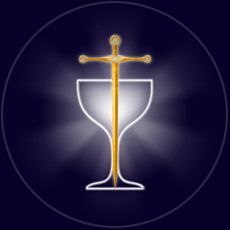

The symbolism of the Sword is double edged. As an emblem of masculine power, it can be wielded for good or for ill. Many tales tell of the ill-fated sword, a blade borne in ignorance or malice that brings misfortune to those who use it. In the Arthurian legends, it was an enchanted sword that brought a curse upon Balin, eventually leading to his part in the creation of the Wasteland. The same sword was later redeemed by the purity of Galahad who, claiming it as his own, took his place at the Siege Perilous and fulfilled his destiny of finding the Grail and lifting the curse of the Wasteland.
The Sword that can wound is the self-same Sword that can heal.
The Sword is an extension of force, be that raw virility or the focussed projection of a keen and active mind. The skill of the mind lies in its ability to differentiate: to sort one thing from another, to perceive differences. It is an act performed by the blade of the mind; the keener the edge, the better able to slice through subtleties. Used well, it can cut to the core of a problem, dissecting the aspects involved and separating a tangle of issues into more easily solvable segments.
But the mind’s great asset can also be its undoing. To dwell too much on differences is to miss the common ground. Furthermore, the force of the mind can be misapplied. Cruel words can cut down a rival; a contemptuous attitude can inflict deep wounds. A Sword wielded without care can create division and unrest.
Just as a Sword can be sharpened, so too can the mind. The finest Sword is well-honed, perfectly balanced, and skilfully wielded, free from malice or anger.
The Sword is a symbol of Kings, a manifestation of Divine Will.
The Sword is the Sun-ray, a shaft of pure solar energy with the power to fertilize the Earth.
The Broken Sword represents a breaking of Will or loss of spiritual integrity.
During a fight with Pellinor, King Arthur’s sword snaps, suggesting a misalignment of Divine Will. It is a valuable lesson for the newly crowned king: realising when and with whom to fight his battles. Integrity must then be restored by Goddess; it is after the breaking of the king’s first sword that Excalibur is bestowed upon him by the Lady of the Lake.
Norse mythology speaks of Gram, the sword used by Sigurd to kill the dragon Fafnir. Gram was forged by Wayland the Smith and embedded in the tree Barnstock by the chief god Odin. In a tantalising parallel to the sword-in-the-stone legend of Arthurian mythology, only one person – Sigur’s father Sigmund – was able to pull Gram out of Barnstock. After being destroyed and reforged, it was said Gram could cut an anvil in two.
In The Lord of the Rings, the sword Narsil is broken in battle and the hilt-shard used to cut the One Ring from the finger of Sauron. Here the broken blade is symbolic of spiritual integrity compromised by the corrupting influence of the Ring; externally, it marks a break in the line of kings. The Sword’s reforging by Elven hands signifies the return of kingship and the restoration of spiritual integrity.
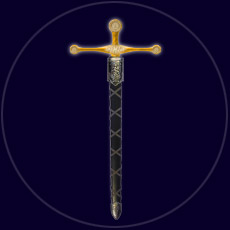
At the heart of the Arthurian myths lies a poignant narrative, which speaks of the loss of the Divine Feminine. The Quest for the Grail is an attempt to reconnect with the deeper wisdom of the Goddess in order to restore wholeness to the kingdom.
Throughout the legends, maidens are often found bestowing swords upon knights. Maidens represent different aspects of the Goddess. In the case of Balin, the maiden requested that the sword be returned, warning of the consequences should he refuse. It was Balin’s own drive for glory and status that led him to keep hold of the sword, and was the cause of the subsequent curse. Balin’s motive – personal glory over devotion to the Goddess – and the act itself – withholding the blade from the maiden – both suggest a separation from the Divine Feminine, for which Balin reaped the consequences.
Regarding Excalibur, legend tells how Merlin once asked the king which he preferred – sword or scabbard. When Arthur voiced a preference for the Sword, Merlin chided him for his shortsightedness.
Ye are more unwise, said Merlin, for the scabbard is worth ten of the swords, for whiles ye have the scabbard upon you, ye shall never lose no blood, be ye never so sore wounded; therefore keep well the scabbard always with you.
Thomas Malory, Le Morte d’Arthur
The scabbard’s theft by Morgan le Fay plays an essential role in the king’s downfall.
There is obvious sexual imagery to the story of a sword and its sheath and on a basic level the theft of the sheath represents a loss or distrust of the Feminine. On a personal level, the implication is a loss of inner wisdom. Without a sheath, the Sword of consciousness is forever directed outwards, into the world at large rather than into the depths of being.
This is reflected in Arthur’s reign. He was a king of war rather than of peace, leading his people well in times of strife but struggling with the arts of love. Famously, he was unable to sire an heir, falling at the hands of his bastard son (the product of misplaced creative energy).
Arthur is a representative of the Divine Masculine, a Warrior Sun King, yet without the Earthing of the Feminine principle he remains unbalanced, until a cataclysmic collision on the fields of Camlann brings about the violent discharge needed to release the build-up of ungrounded solar energy.
In comparison to the Sword without a Scabbard, the Re-sheathed Sword, instead of being directed at the external world, is directed inwards. It is directed towards the Inner Life, where the greatest wisdom lies.
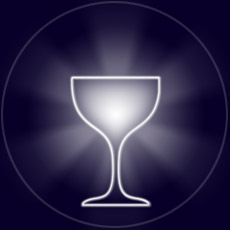
Of the Grail less can be said than the Sword, for the Grail holds the universal wisdom that rises up to meet us when the mind is stilled.
Obvious parallels exist between Grail and Scabbard: both are feminine symbols, receptive vessels carrying the life-force; both are said to convey immortality.
Goddess wisdom cannot be taught. It is to be experienced.
In these pages, more attention is placed upon the Sword because it is the part of us we can change in order for the Grail to come to the fore. The Grail just is.
The metaphor of the butterfly is appropriate. Chase the Grail and it remains out of reach; learn receptivity and we may be graced with its presence.
Still the chattering mind and hone the blade of consciousness. Return the Sword to its Scabbard by bringing the attention from the external world of illusion to the Inner Life, and the Grail is waiting for us to discover – it lies within.

 TOP
TOP